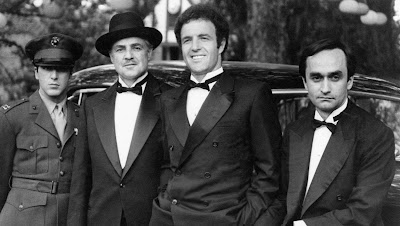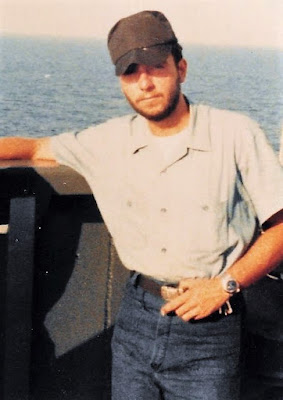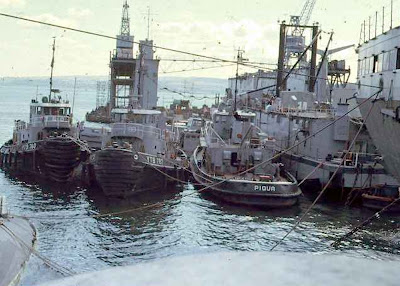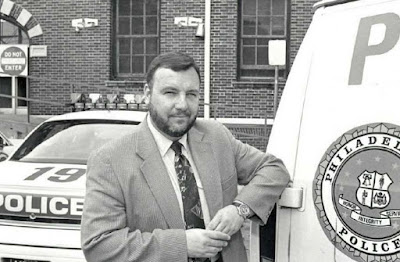As I noted in my previous
post, on this day in 1975 I left the U.S. Navy’s nuclear submarine base at Holy
Loch, Scotland, ending two years of service aboard the U.S. Navy harbor tugboat
USS Saugus (YTB-780).
I had a number of interesting
adventures aboard the Navy tugboat, the workhorse of the floating submarine
base, as we towed submarines, ships and barges in and around Holy Loch.
The
Saugus was also ordered out into the Irish Sea, an awful and dangerous place to
be in winter with gale force winds and 50-foot waves. We ventured out to the Irish
Sea to rendezvous with submarines and perform operational exercises, medical
evacuations and classified missions. I also traveled extensively on leave across
the United Kingdom and Continental Europe.
My enlistment would end in
February of 1976, and I received orders to report to the Philadelphia Navy Yard for my final month in the Navy. I was annoyed that the Submarine Squadron kept me in Scotland over
Christmas and would not fly me home until the 28th.
I was assigned a seat on a
Navy chartered commercial aircraft among a submarine crew and Navy wives and children
and we flew from Prestwick Airport to Maguire Air Force Base in New Jersey.
In a black tie and my double-breasted
dress blue jacket and slacks, looking like an officer or chief (this was before the Navy
changed back to the old uniform), I settled in. Once in the air, I asked the
airline stewardess (this was before they were called Flight Attendants) for a
Vodka on the Rocks.
She smiled and replied that
no alcohol was served on Navy chartered flights. Once again, I cursed the
Submarine Squadron officer who assigned me to this flight. Had I known that no alcohol
would be served, I would have carried on board my flask filled with Vodka (I
drank a bit in those days).
It was a long and uneventful flight,
and as I could not sleep, I read a book that I brought along. I also sat back
and thought about my past adventures in Scotland.
We landed at Maguire Air Force Base in the early evening. As we deplaned, we were herded in a waiting
room and held there for some time without an explanation. Finally, an official
came in and announced that a child on our flight had turned blue. The child was
now recovering, but until the cause of his illness was determined, we would be
held in quarantine.
After the long flight, we
were forced to sit in the waiting room for several more hours. Finally, we were
released and allowed to leave the terminal.
The other sailors and their families
were met by other family members and driven off the base. I didn’t call anyone
in my family, as I wanted to surprise them. At this late hour, I discovered
that the buses to Philadelphia had stopped running and there would not be
another bus until early morning. Not wanting to spend the night in a deserted
terminal with no bar or restaurant, I went outside and asked the sole cab driver how
much it would cost to take me to South Philadelphia. He said $50.
“Your piece of shit cab isn’t
worth $50,” I replied.
He shrugged and drove off, I
went back into the terminal and thought about how I was going to get home.
I didn’t want to call my
elderly father or my older brother and ask them to drive the more than 40 miles
from South Philly to the airbase. I pulled out my address book and called my
good friend Buster.
Buster’s wife answered and I asked
her if Buster was home.
“He’s gone to pick you up,” she
said.
I thanked her and said I would see her soon.
I was confused as I had not
told Buster or anyone else when I was coming home. Then it dawned on me that Buster had
used my homecoming as an excuse to get out of the house. Buster, my old
drinking buddy, was a character and a wild man.
I called the Lamplighter, our
old bar in South Philly and asked for Buster. He was there.
He thought it funny that he
lied to his wife about me coming home, and it turned out to be actually true.
He said he would come and get me.
I sat in a chair and read my
book for about a half-hour and then went outside the terminal and smoked a cigar.
Sometime later, a jeep with two Air Police sergeants pulled up.
“Are you Paul Davis?” one of
them asked.
Yes, I replied, a bit
confused.
“There are some guys at the
gate who want to pick you up,” one of the sergeants explained. “But they are so
drunk, we won’t let them in.”
They offered to drive me to
the gate, and I tossed my sea bag in the jeep and sat in the back, and they
raced to the gate. Outside of the gate stood Buster, along with my other South
Philly friends, Stevie, Frenchie and Buddy, all quite drunk. I hesitated to get
into the car, but what choice did I have?
Buster drove precariously
through the New Jersey roads, and we quickly became lost. Buster saw a bar and
announced he would go in and ask directions.
We all piled out of the car
and went into the bar. I saw that the dingy and dark taproom was an outlaw
biker bar, and we received some threatening looks. We were outnumbered
five-to-one. But Buster and Stevie were two very tough South Philly hoodlums in their
late 20s who feared no one. Frenchie and Buddy could take care of themselves, and as a former South Philly street kid and former boxer, I could also handle myself. I'd thought the odds were in our favor.
The bikers could see that we weren’t
afraid of them, and they relaxed. Two of the bikers saw that I was in uniform and
came over and shook my hand and offered us all a beer.
We drank with the bikers
until 2 am when the bar closed. I passed out in the back seat, so I thankfully
don’t any memory of how Buster made it home to South Philly.
Buster dropped the other guys
off at their homes and we went to his house. He broke
out the booze and we continued drinking. As the morning approached, Buster’s wife
cooked us breakfast and I drank several cups of coffee.
At around 8 am, Buster drove
me to my parent’s house.
I knocked on the door and my
dog, the dog I had raised from a puppy, barked furiously.
My mother asked apprehensively
who was there from behind the closed door.
“It’s your son!”
My dog continued barking at
me as my mother opened the door and embraced me.
I would spend the next month
at the Philadelphia Navy Yard, but once the chief there discovered I lived in
South Philly, he gave me a lot of time off.
As I traveled much and drank much
in bars and clubs, I didn’t save any money in Scotland, but I had 30 days leave saved and I counted on that money.
On the day of my discharge, I
asked where my check was and I was told that my leave papers were not among my
orders, so I would have to wait for them to recover my documents and then they
would mail a check to me.
I was furious. I saw the chief and he said he
was sorry, but there was nothing he could do. I shook his hand and walked out
of the gate of the Navy Yard.
In a sense, my
dual career in government and journalism began at the Philadelphia Naval Yard,
as I sold Philadelphia newspapers there to the sailors and civilian yard
workers as a teenager in the 1960s. So it seemed fitting that I ended my Navy
service there.
I served two years on the
aircraft carrier USS Kitty Hawk during the Vietnam War and another two years on
the tugboat USS Saugus. I served on one of the largest warships in the world and
then served another two years on a 100-foot tugboat.
Even after all these years, I
retain fond memories of the things I've done, the places I’ve seen, and the
good friends I made in the U.S. Navy.
You can read my previous post via the below link:
Paul Davis On Crime: Davis Departing II: On This Day in 1975 I Departed the Navy Tugboat USS Saugus
And you can read my other vignettes, short stories and humor pieces via the below link:
Paul Davis On Crime: Sea Stories: Vignettes, Short Stories And Humor Pieces About My Time In The U.S. Navy















































